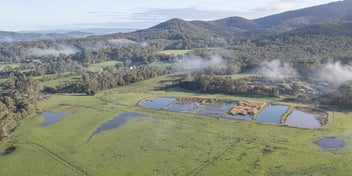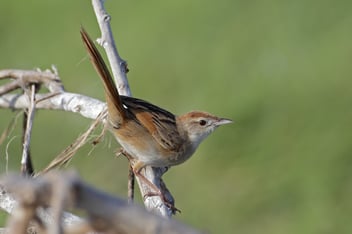Conservation effort releases rare fish into wild
A new conservation program has seen populations of a critically endangered fish released into the wild for the first time.
The red-finned blue-eye, Australia's smallest and rarest freshwater fish, has been on the brink of extinction for decades, but now a never-before-trialled conservation and breeding program could build its numbers.
The tiny species, which grows to only three centimetres long, or the size of a matchstick, is an Australian native species found solely in the Great Artesian Basin springs on Edgbaston Reserve in remote western Queensland.
The species was facing extinction thanks to the aggressive, invasive gambusia — or mosquito fish — until a the conservation and captive breeding program was conducted.
The fish's population numbers have been boosted from a couple of hundred to about 3000 since not-for-profit conservation organisation Bush Heritage bought Edgbaston Reserve in 2008.
The group undertook a two-pronged approach to try to save the red-finned blue-eye.
Firstly, it moved fish from the single remaining wild population to other springs safe from gambusia, and took measures to control gambusia numbers at the reserve, such as installing small mesh fences to stop the species moving between springs during floods.
More recently, Bush Heritage trialled a program to breed red-finned blue-eye in captivity by creating artificial springs that replicate the fish's natural habitat.
"Gambusia is probably the single-most individual species that is successfully outcompeting everything else in Australia," said Queensland president of the Australia New Guinea Fishes Association, Graeme Finsen.
The red-finned blue-eye is not the only species endemic to Edgbaston's artesian springs.
More than two dozen species of flora and fauna, including 11 types of snails and at least a dozen plants, are found nowhere else in the world.
Scientists do not yet know what flow-on effects the extinction of the red-finned blue-eye could have had, but its role as the top predator in a rare ecosystem means that being able to save them is critically important.
Finsen said we can’t simply say that, since it’s a tiny fish, it does not matter if it becomes extinct.
"If we lose the red-finned blue-eye, do we lose the eriocaulon? And if we lose that plant, is that plant food for 11 different species of snail?” he said.
"When you remove one species, you're taking out more. It's not just this one little thing; it's a whole interconnected community of unique little springs that we risk losing.
"If we can keep that one going, we can probably keep more species going that are on the endangered list."


